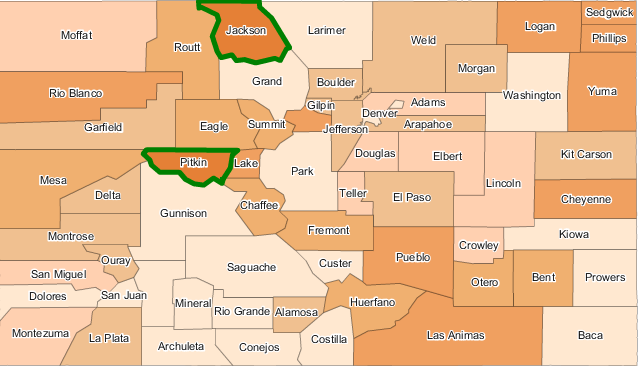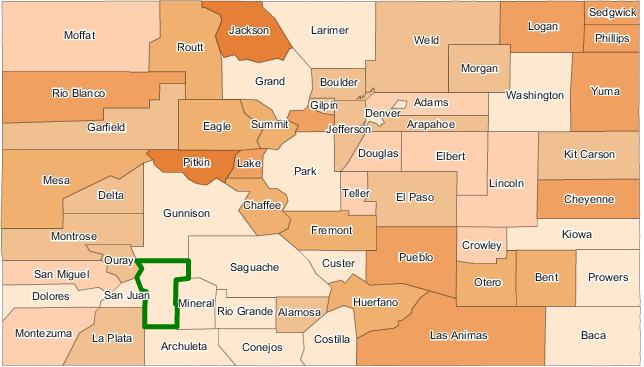By Katie Kerwin McCrimmon
An MRI on your knee in Colorado could cost as little as $297 or as much as $1,261 depending on where you get it, according to the first release of health data from a powerful new tool aimed at improving health, bringing down costs and improving the quality of care.
On Thursday, Colorado became the 12th state in the nation to unveil an All Payer Claims Database (APCD) with the debut of www.cohealthdata.org managed by the Center for Improving Value in Health Care (CIVHC).
So far, the database includes about 40 percent of health data from 2009 to 2011, representing about 2 million people (all under 65) who were covered through both private and public health insurance programs in Colorado. By 2014, CIVHC managers hope to add data from Medicare patients along with claims from self-insured private employers to reflect about 90 percent of insured Coloradans.

Pitkin and Jackson counties had the highest per-person health costs in 2011. Source: Colorado All Payer Claims Database. (Click on image to enlarge.)
APDC managers are not yet naming the hospitals or doctors who provide the most bang for the buck in Colorado. That information is due to be available in coming years.
But, there are already some surprises in the data. For instance, initial reports show that Mesa County, an area heralded nationally for high rates of health insurance and relatively low-cost care has higher than average costs for commercially insured patients. Mesa, Delta and Montrose Counties matched statewide averages for Medicaid coverage, but were higher than average for privately insured patients.
In terms of total cost of care for 2011, ritzy Pitkin and remote Jackson counties topped the state with average costs of $4,054 and $3,580 respectively per member per year. Meanwhile, tiny Hinsdale County in southwestern Colorado had the lowest average per member costs of just $1,012.
Targeted first at health care providers, the health data bank eventually should help insurance companies demand more uniform costs from doctors and hospitals. And down the road, consumers will be able to search by procedure to see both cost and quality ratings for doctors and hospitals.
Experts at CIVHC hope transparency about the cost of care will encourage everyone from policy experts to insurance bean counters, business owners and individuals to ask tough questions about why there are so many discrepancies in the cost and quality of care. The database should also allow communities to evaluate disparities and costs at the local level.
Phil Kalin, president and CEO of CIVHC, said the evidence is clear that exorbitant health spending in the U.S. is not buying greater quality. The U.S. ranks 37th in the world in terms of overall quality of care while spending $2.8 trillion a year on the health sector.
He said the database should help achieve the so-called triple aim: better health and better quality care at lower costs.
If youre a consumer, what does something cost? Consumers want to make the best decisions and providers need data to compare themselves to their peers. For business owners, the costs of premiums are unsustainable, Kalin said.
And lawmakers need better information so they can fund health programs that work and promise a good return on investment.

Hinsdale County had the lowest per-person health costs in 2011. Source: Colorado All Payer Claims Database. (Click on image to enlarge.)
Dr. Ned Calonge, president and CEO of The Colorado Trust, which is helping to fund the data bank, said its not the first time Colorado has tried to harness data to improve health care. At least two previous attempts made progress then died.
Calonge said its time for the effort to succeed since lives are at stake.
These data are complex with lots of numbers. But they tell us real stories about lots of people, people who are suffering because they cant afford health insurance, he said.
Anne Warhover, president and CEO of the Colorado Health Foundation, which is also funding the APCD said Colorado can become a laboratory for the nation if policymakers can find a way to truly bring down costs while improving health.
Dr. Jonathan Mathieu, director of data and research for CIVHC, unveiled the kind of data that the APCD will eventually provide.
In Utah, for instance, health officials found that people with one or two chronic diseases were responsible for 53 percent of health costs in the state. Once Colorados system is fully in place, Mathieu expects it to uncover similar patterns that can help drive policy.
Mathieu spent last week at a conference with health data specialists and said there was a great deal of buzz about the Colorado system.
We will have one of the most robust data collection systems in the U.S.
